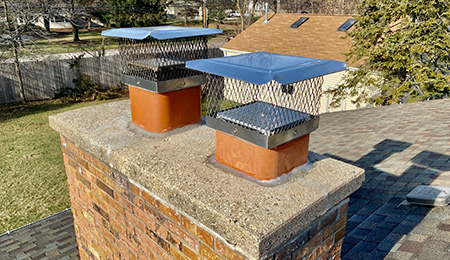Chimney Top Sealing Dampers

Top sealing dampers have dual utilization. They are manufactured to seal the flue at the very top of the chimney to prevent draft, saving on energy costs as well as providing a rain cap with animal cage surround. These are often recommended when the internal damper system has either failed or needs to be removed to repair portions of the smoke chamber or lining system.
However, some customers elect to have them installed to save on energy costs and prevent draft. They may also help with keeping the ever notorious stink bugs from entering the chimney system when sealed closed.
What To Expect:
During your estimate, our technician will determine what size of top sealing damper is required for your specific fireplace flue system. Once we are able to determine the size of damper needed, and whether the internal damper system needs to be removed, they will be able to provide an estimate to install.
Installation is fairly non-invasive and can generally be completed within a single appointment window. A bracket is installed within the firebox that will hold the damper chain tightly in place when in the closed position. The damper is placed at the top of a clay flue tile on the exterior of the chimney flue. Each damper is constructed of stainless steel with animal screening to aid in keeping animals and debris out when the damper is in the “open” position.
How Do I Operate My Top Sealing Damper?
Closed:
When your fire is out and the system has had time to cool, you can place your damper in the “closed” position. To close the damper, pull the damper down until the lug is below the bracket enabling you to slip the damper chain into the provided notch.
Open:
When opening your damper, release the damper chain from the notch and gently release the damper chain. The damper chain should hang approximately 7 inches above the installed bracket. If you are noticing the damper chain is only moving up and out of the bracket an inch or two, it is important to check that the damper is indeed in the open position.
In the instance of below freezing temperatures and the damper is not opening as usual, condensation may have formed ice causing the components not to release as intended. Giving the cord a few light tugs to break the ice may release the damper. If this does not work, we recommend leaving the damper chain in the “open” position allowing the damper to pop open once the sun warms the surface area. If it becomes a continuous issue, please give our office a call and we will be happy to come out to assist and provide additional preventative measures.
Scheduling Your Damper Installation:
Once an estimate is provided and agreed upon, we will require a signed copy of your proposal to be returned to the office. If being completed independently of chimney flue or smoke chamber work, we will schedule an appointment window for a technician to install your new top sealing damper. If your damper is in correlation with other necessary work, its installation will be scheduled with your fireplace liner or parging project.

